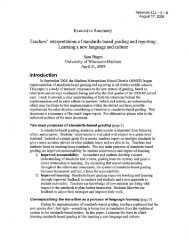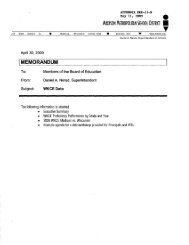Madison Preparatory Academy - School Information System
Madison Preparatory Academy - School Information System
Madison Preparatory Academy - School Information System
You also want an ePaper? Increase the reach of your titles
YUMPU automatically turns print PDFs into web optimized ePapers that Google loves.
Presently, ULGM operates the <strong>School</strong>s of Hope Partnership in 18 middle and high schools in the <strong>Madison</strong>,<br />
Middleton, Oregon and Sun Prairie school districts, and provides in-school academic tutoring services to<br />
more than 2,000 students annually with the support of 950 volunteer tutors. It also offers the 21 st Century<br />
Careers and Summer REACH Programs in Sun Prairie middle schools and coordinates MSCR’s after school<br />
programs in several <strong>Madison</strong> middle schools. Additionally, the Urban League has already served more than<br />
400 adults through its workforce training programs this year, with nearly 49% finding employment (against a<br />
goal of 45%).<br />
ULGM presently has partnerships with 83 different organizations and agencies, and is poised to engage<br />
several of its partners in support of <strong>Madison</strong> Prep, its students, faculty, staff and families.<br />
History and Background on Student Achievement in <strong>Madison</strong><br />
In 1965, as a part of her Master’s Thesis, Cora Bagley conducted a study on the academic achievement of African<br />
American students. In her thesis, she reported that a low level of academic achievement existed among Black<br />
students. On standardized achievement tests of language usage, 68% of African American high school students<br />
scored “below the standard level” in language usage. Similarly, 54% scored below the standard in math and 39%<br />
scored below the standard in reading. 5<br />
Ms. Bagley also reported that 26% of African American students entering <strong>Madison</strong>’s high schools failed to<br />
graduate, that females were more susceptible to dropping out of high school than males, and that “Negro students<br />
not only fail to complete high school but many of those who finish do not pursue higher education.” Among the<br />
29,000 students attending the University of Wisconsin at the time, Ms. Bagley reported that only three African<br />
American students gave <strong>Madison</strong> home addresses and only one had graduated from a <strong>Madison</strong> high school.<br />
In a January 31, 1965 Wisconsin State Journal article entitled “<strong>Madison</strong> Negroes still face entrapping circle,”<br />
Sharon Cody wrote that there was a prevailing belief that “<strong>Madison</strong> Negroes still faced the entrapping circle of<br />
disprivileged homes, poor education, few employment opportunities, and inadequate housing, but legal obstacles<br />
were disappearing.” Curiously, in Dr. Naomi Lede’s 1966 report, <strong>Madison</strong>’s Negro Population, she shared that<br />
her surveys of <strong>Madison</strong>’s White and Black residents indicated that “there is no prevailing atmosphere of racial<br />
conflict in <strong>Madison</strong>,” with most leaders from both groups reporting that everyone appeared “to get along” with<br />
one another. 6<br />
Despite poor educational outcomes among Black students at the time, Ms. Lede found that “relatively few, if any,<br />
of <strong>Madison</strong> residents expressed any anxiety concerning the integration of <strong>Madison</strong>’s schools.” She said 52% of<br />
African Americans “were satisfied with desegregation in the schools, even though the majority of Black children<br />
were assigned to Franklin Elementary, Lincoln Middle, and Central High <strong>School</strong>s. The other 48% had “no<br />
thoughts on desegregation.” African Americans seeking social and professional advancement cited limited<br />
employment options that offered social and professional advancement as the most important challenge facing the<br />
Black community. Many of these African Americans were college educated or worked in government and other<br />
professional jobs. At the same time, lower-income African Americans identified a lack of access to quality<br />
housing as the most important issue. The majority of these residents worked in blue collar jobs.<br />
A 1966 research survey conducted by the University of Wisconsin-<strong>Madison</strong> <strong>School</strong> of Social Work further<br />
highlighted the employment status of African Americans. It found that seven out of 10 African Americans in the<br />
labor force who resided in South <strong>Madison</strong> held blue collar jobs. Of the 143 households interviewed (94 men and<br />
67 women), 110 (77%) had one or more persons employed full-time. Eighty-four of the African American men<br />
interviewed were head of their households and held full-time jobs (89%). There were also 42 wives who held fulltime<br />
employment and just 12 employed women were heads of their households (29%).<br />
The study also found that 49% of African Americans who were employed full-time had no formal job training,<br />
while 27% had vocational school training, 19% had on-the-job training, and 5% had “in-service training”. Seven<br />
percent also reported job training in the armed forces and 8% mentioned receiving business college training as<br />
9 | P age


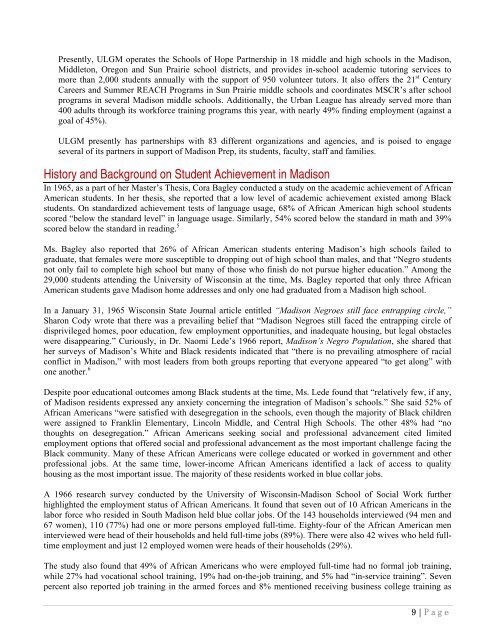
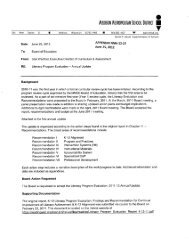
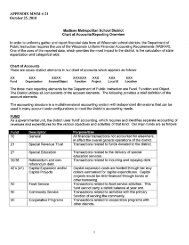
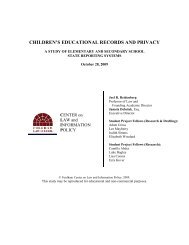

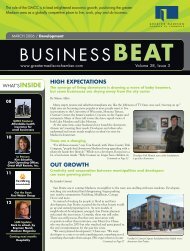
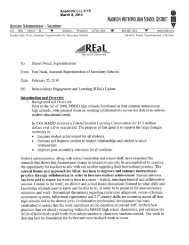
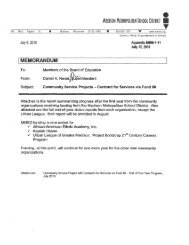
![by Shaina Wright [PDF] Ralph Waldo Emerson Prize 2006 - School ...](https://img.yumpu.com/26083584/1/174x260/by-shaina-wright-pdf-ralph-waldo-emerson-prize-2006-school-.jpg?quality=85)
